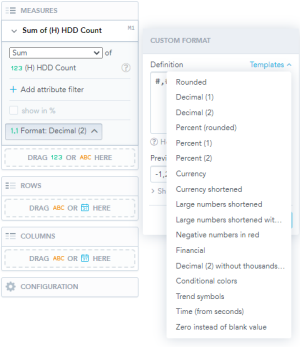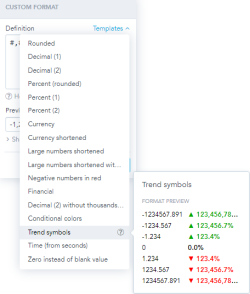Formatting Numbers
Note:
You can customize the format of the measures and attributes you add to the Measure section in your insights. For example, you can round numbers, shorten large numbers, display fixed number of zeros, display currency symbols, add colors, and so on.
For every measure and attribute in your Measures section, you can configure your own custom format using specific syntax or select from a variety of predefined formats.
The formatting applies only to the individual measure/attribute instance and current insight.
Refer to the following subsections on this page:
| • | Regional Settings |
| • | Defining Custom Number Formats |
| • | Digit Placeholders |
| • | Selecting Predefined Number Formats |
| • | Predefined Formats |
| • | Default Format |
Your regional settings define how the decimal point and the thousands separator are displayed in your insights.
Defining Custom Number Formats
The custom number format enables you to:
| • | Select a specific format from various formatting templates |
| • | Define your own number format |
| • | Adjust an already selected format. |
For information about placeholders' syntax in definitions, see Digit Placeholders.
To define custom number formats:
| 1. | In the Measures section, click Format > Custom in the measure settings. |

| 2. | In the custom format section, do one of the following: |
| a. | In the format definition, use digit placeholders. |
| b. | Click Templates to select from a list of predefined formats. |

| c. | Hover your mouse over the question mark on the right side of the template name to display examples of the formatting. |

| d. | Adjust a previously defined/selected format in the Definition section. |
| 3. | Click Apply. |
The insight now displays the numbers in your selected format.
When defining your custom number format, use the following placeholders to define the custom number format.
|
Placeholder |
Description |
|
0 |
Digit placeholder. The number of 0 (zeros) in the format definition corresponds with the numbers of digits displayed. |
|
# |
Digit placeholder. Displays digits without extra 0 (zeros). |
|
. |
Decimal point. Based on your Regional Settings, displays as. (dot) or, (comma). |
|
, |
Thousand’s separator. Based on your Regional Settings, displays as, (comma) or. (dot). |
|
% |
Percentage placeholder. Multiplies the value by 100 and adds the % (percentage) character. |
Selecting Predefined Number Formats
Data Explorer offers predefined formats you can choose from.
To choose a predefined number format:
| 1. | In the Measures section, click Format in the measure settings. |

| 2. | In the dropdown menu, select a format. |

For details, see the Predefined Formats section.
The insight now displays the measure in your selected format.
The following table provides descriptions of predefined formats.
|
Placeholder |
Description |
Format |
Input Examples |
Output Examples |
|
Inherit |
The format is inherited from the definition in Manage > Metrics section. |
- |
- |
- |
|
Rounded |
Number with the thousand's separator rounded to the nearest whole number. |
#,##0 |
1234.5678 |
1,235 |
|
Decimal (1) |
Number with one decimal digit. |
#,##0.0 |
1234.5678 |
1,234.6 |
|
Decimal (2) |
Number with two decimal digits. |
#,##0.00 |
1234.5678 |
1234.57 |
|
Percent |
Number multiplied by 100 with the thousand’s separator rounded to the nearest whole number. |
#,##0% |
1,234.5678 |
123,457% |
|
Percent (1) |
Number multiplied by 100 with the thousand's separator with one decimal digit. |
#,##0.0% |
1,234.5678 |
123,456.8% |
|
Percent (2) |
Number multiplied by 100 with the thousand's separator with two decimal digits. |
#,##0.00% |
1,234.5678 |
123,456.78 |
When you add measures or attributes to your insight, Data Explorer assigns the following default number formats.
| • | Measures > Decimal (2)—Measures are displayed as numbers with two decimal digits. |
| • | Calculated measures > Inherited—Calculated measures inherit the format from their definition in the Manage > Metrics section. |
| • | Attributes > Rounded—Attributes (count of attributes) are displayed as rounded whole numbers. |
If you enable show in %, the default format will switch to Percent (2).